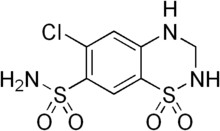Renal artery stenosis
| Renal artery stenosis | |
|---|---|
 | |
| |
| Classification and external resources | |
| Specialty | cardiology |
| ICD-10 | I70.1 |
| ICD-9-CM | 440.1 |
| DiseasesDB | 11255 |
| MedlinePlus | 001273 |
| eMedicine | med/2001 |
| MeSH | D012078 |
Renal artery stenosis is the narrowing of one of the renal arteries, most often caused by atherosclerosis or fibromuscular dysplasia. This narrowing of the renal artery can impede blood flow to the target kidney, resulting in renovascular hypertension – a secondary type of high blood pressure. Possible complications of renal artery stenosis are chronic kidney disease and coronary artery disease.[1]
Signs and symptoms
Most cases of renal artery stenosis are asymptomatic, and the main problem is high blood pressure that cannot be controlled with medication.[2] Decreased kidney function may develop if both kidneys do not receive adequate blood flow, furthermore some people with renal artery stenosis present with episodes of flash pulmonary edema.[3]
Cause
Renal artery stenosis is most often caused by atherosclerosis which causes the renal arteries to harden and narrow due to the build-up of plaque. This accounts for about 90% of cases with most of the rest due to fibromuscular dysplasia.[4] Fibromuscular dysplasia is the predominant cause in young patients, usually females under 40 years of age.[5]
Pathophysiology
The pathophysiology of renal artery stenosis, leads to changes in the structure of the kidney that are most noticeable in the tubular tissue.[6] If the stenosis is longstanding and severe, the glomerular filtration rate in the affected kidneys never recovers and (prerenal) kidney failure is the result.
Changes include:[6]
- Fibrosis
- Tubular cell size (decrease)
- Thickening of Bowman capsule
- Tubulosclerosis
- Glomerular capillary tuft (atrophy)
Diagnosis

The diagnosis of renal artery stenosis can use many techniques to determine if the condition is present, a clinical prediction rule is available to guide diagnosis.[7]
Among the diagnostic techniques are:
- Doppler ultrasound study of the kidneys[8]
- refractory hypertension[9]
- auscultation (with stethoscope) - bruit ("rushing" sound)[10]
- captopril challenge test[11]
- captopril test dose effect on the differential renal function as measured by MAG3 scan.
- renal artery arteriogram.[12][13]
Treatment

Atherosclerotic renal artery stenosis
It is initially treated with medications, including diuretics, and medications for blood pressure control.[6] When high-grade renal artery stenosis is documented and blood pressure cannot be controlled with medication, or if renal function deteriorates, surgery may be resorted to. The most commonly used procedure is a minimally-invasive angioplasty with or without stenting. It is unclear if this approach yields better results than the use of medications alone.[14] It is a relatively safe procedure.[14] If all else fails and the kidney is thought to be worsening hypertension and revascularization with angioplasty or surgery does not work, then surgical removal of the affected kidney (nephrectomy) may significantly improve high blood pressure.[15]
Fibromuscular dysplasia
Angioplasty with or without stenting is the best option for the treatment of renal artery stenosis due to fibromuscular dysplasia.[16]
See also
References
- ↑ "Renal Artery Stenosis". National Institute of Diabetes and Digestive and Kidney Diseases. Retrieved 2015-08-17.
- ↑ "Renovascular hypertension: MedlinePlus Medical Encyclopedia". www.nlm.nih.gov. Retrieved 2015-08-17.
- ↑ Messerli, Franz H.; Bangalore, Sripal; Makani, Harikrishna; Rimoldi, Stefano F.; Allemann, Yves; White, Christopher J.; Textor, Stephen; Sleight, Peter (2011-03-15). "Flash pulmonary oedema and bilateral renal artery stenosis: the Pickering Syndrome". European Heart Journal. 32: ehr056. doi:10.1093/eurheartj/ehr056. ISSN 0195-668X. PMID 21406441.
- ↑ "RenalArtery Stenosis" (PDF). NIH. National Institute of Health. Retrieved 1 August 2016.
- ↑ "Fibromuscular Dysplasia: Practice Essentials, Background, Pathophysiology".
- 1 2 3 "Renal Artery Stenosis: Background, Pathophysiology, Etiology".
- ↑ Steyerberg, Ewout (2008-12-16). Clinical Prediction Models: A Practical Approach to Development, Validation, and Updating. Springer Science & Business Media. ISBN 9780387772448.
- ↑ Granata, A.; Fiorini, F.; Andrulli, S.; Logias, F.; Gallieni, M.; Romano, G.; Sicurezza, E.; Fiore, C.E. (2009-10-12). "Doppler ultrasound and renal artery stenosis: An overview". Journal of Ultrasound. 12 (4): 133–143. doi:10.1016/j.jus.2009.09.006. ISSN 1971-3495. PMC 3567456
 . PMID 23397022.
. PMID 23397022. - ↑ Protasiewicz, Marcin; Kądziela, Jacek; Początek, Karol; Poręba, Rafał; Podgórski, Maciej; Derkacz, Arkadiusz; Prejbisz, Aleksander; Mysiak, Andrzej; Januszewicz, Andrzej (2013-11-01). "Renal artery stenosis in patients with resistant hypertension". The American Journal of Cardiology. 112 (9): 1417–1420. doi:10.1016/j.amjcard.2013.06.030. ISSN 1879-1913. PMID 24135303. – via ScienceDirect (Subscription may be required or content may be available in libraries.)
- ↑ Talley, Nicholas Joseph; O'Connor, Simon (2013-09-20). Clinical Examination: A Systematic Guide to Physical Diagnosis. Elsevier Health Sciences. ISBN 9780729541473.
- ↑ Ong, Yong Yau (2005-01-01). A Clinical Approach to Medicine. World Scientific. ISBN 9789812560735.
- ↑ Sam, Amir H.; James T.H. Teo (2010). Rapid Medicine. Wiley-Blackwell. ISBN 1405183233.
- ↑ Attenberger, Ulrike I.; Morelli, John N.; Schoenberg, Stefan O.; Michaely, Henrik J. (2011-11-15). "Assessment of the kidneys: magnetic resonance angiography, perfusion and diffusion". Journal of Cardiovascular Magnetic Resonance. 13 (1): 70. doi:10.1186/1532-429X-13-70. ISSN 1532-429X. PMC 3228749
 . PMID 22085467.
. PMID 22085467. - 1 2 Jenks, S; Yeoh, SE; Conway, BR (5 December 2014). "Balloon angioplasty, with and without stenting, versus medical therapy for hypertensive patients with renal artery stenosis.". The Cochrane database of systematic reviews. 12: CD002944. doi:10.1002/14651858.CD002944.pub2. PMID 25478936.
- ↑ Fine, Richard N.; Webber, Steven A.; Harmon, William E.; Kelly, Deirdre; Olthoff, Kim M. (2009-04-08). Pediatric Solid Organ Transplantation. John Wiley & Sons. ISBN 9781444312737.
- ↑ "Treatment of hypertension in patients with renal artery stenosis due to fibromuscular dysplasia of the renal arteries - Chrysant - Cardiovascular Diagnosis and Therapy". www.thecdt.org. Retrieved 2015-08-17.
Further reading
- Schrier, Robert W. (2010-01-01). Renal and Electrolyte Disorders. Lippincott Williams & Wilkins. ISBN 9781608310722.
- "Efficacy of revascularization for renal artery stenosis caused by fibromuscular dysplasia: a systematic review and meta-analysis". www.crd.york.ac.uk. Retrieved 2015-08-17.
- "Diagnostic tests for renal artery stenosis in patients suspected of having renovascular hypertension: a meta-analysis". www.crd.york.ac.uk. Retrieved 2015-08-17.